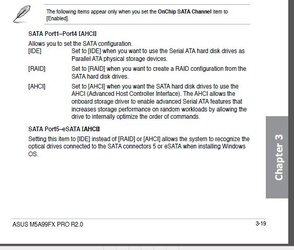Amen! The trick is to beat the little woman to the punch when you release methane. Quickly say, "Honey, did you do that?" with a contorted look on your face.
It's not that both sexes don't fart. It's just that yours is the only one that regards it as an achievement.
so what i currently have setup is SSD (OS) on sata port 5, optical drives on both asmedia ports (turned out to work just fine), and my HDD's (currently just 2 but have other 2 in the mail on the way) on ports 1 and 2 (others 3 and 4 when they arrive) in raid 1 setup by windows.
what i would like to do is a raid 10 with the mobo but i couldnt figure anything out after hours of messing around (after the first hour i messed up something and spent the next 5 trying to get windows installed again... long story) so gave up and went with windows raid. durring the whole ordeal i read that the mobo raid has a little better performance than windows but to do that i would have to set the ssd to ide (which has much lower performance??) or raid and exclude it from the group (dont know how to or know performance issues if any).
so, does the mobo raid have that much better performance (if you can give numbers that would be great), and how would i get the ssd to work right if i do do it that way (really dont want to install the os again)?
I don't have my own numbers, but I have someone else's if you're interested:
http://kmwoley.com/blog/?p=429
The thing to realize, is that whilst there is a large difference (I would hope!) between real hardware RAID and OS RAID, the in-built RAID on your motherboard is a long way from being proper hardware RAID. It's commonly called "Fake RAID" for this reason. It's not actually distinct from the OS. It relies on drivers in the OS that are pretty much actual RAID implementations in software. According to the link above, they can actually use
more CPU power than the software RAID built into the OS. It's a shame the author didn't include a GNU/Linux software RAID, it would be interesting to see how it compares.
Anyway, I personally do not care for Fake RAID. Given that the gains range from marginal to non-existent (or even detrimental in the testing above), I've preferred to just keep things clean and do it in Windows. It's possible that there are or will be motherboards with more professional RAID built in, but the ones I'm aware of have always been extremely weak.
One thing that is worth bringing up, although it's not your question, is Storage Spaces in Windows 8 / Server 2012. Windows 8 still supports just opening Disk Management and creating "Dynamic Disks" so its easy to miss that this approach is semi-deprecated. Assuming you have Windows 8, what you should do is create some Storage Spaces. This lets you create your RAID 10 which the old method doesn't do (so far as I'm aware).
As is typical with MS, they've invented their own "simpler" terminology, but once you get your head around it, it's fine. What you want to do is create a mirrored storage space with multiple columns. The degree of mirroring is how many copies you have and the number of columns is how many sets the data is striped across. So if you have four disks, you can create a storage space with a 2-way mirror and two columns, and that's your basic four-disk RAID 10. I.e. your data striped across two disks and then both those mirrored on two more. I'll see if I can dig out the article I read on performance of Storage Spaces. Pretty decent if I recall. (Not comparable to hardware RAID, but I seriously doubt it is worse than the Fake RAID you get on motherboards). Very easy to manage as well and its the focus of MS's performance improvements going forward.


